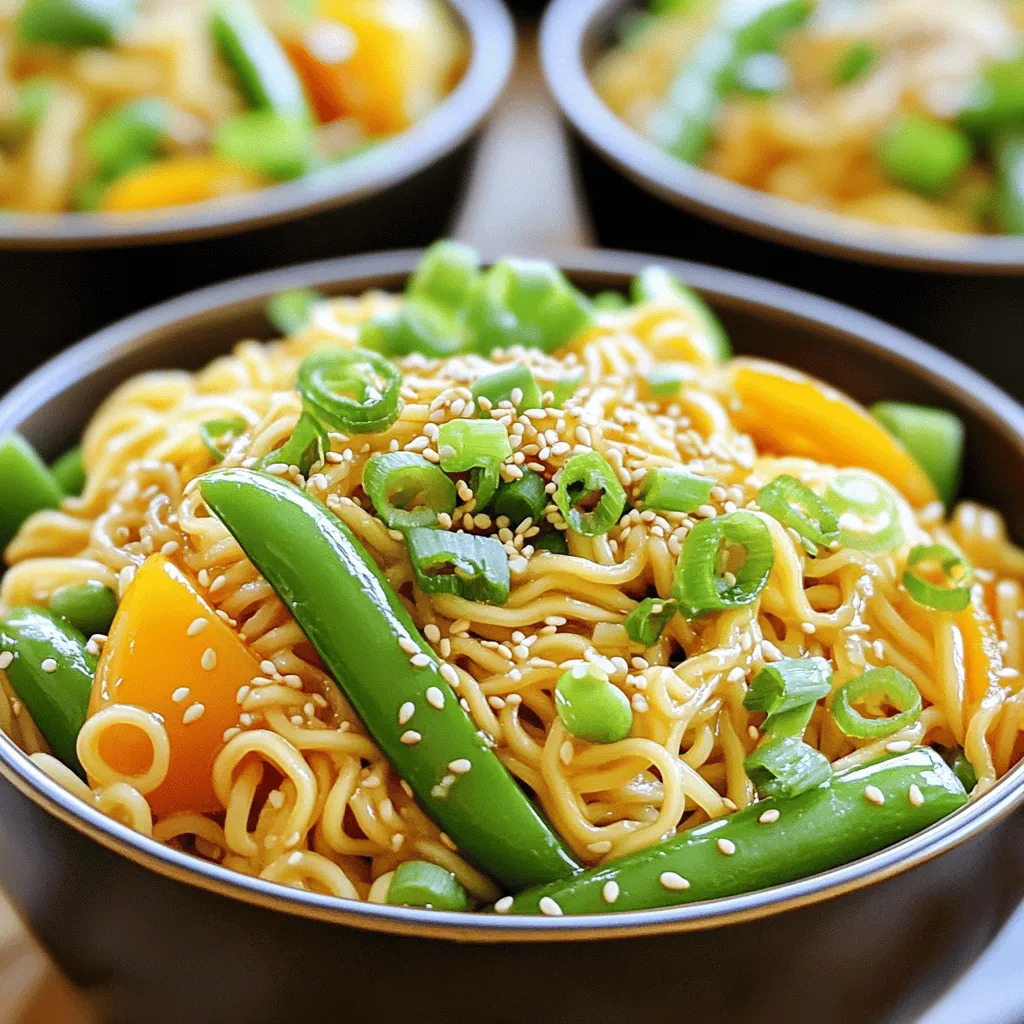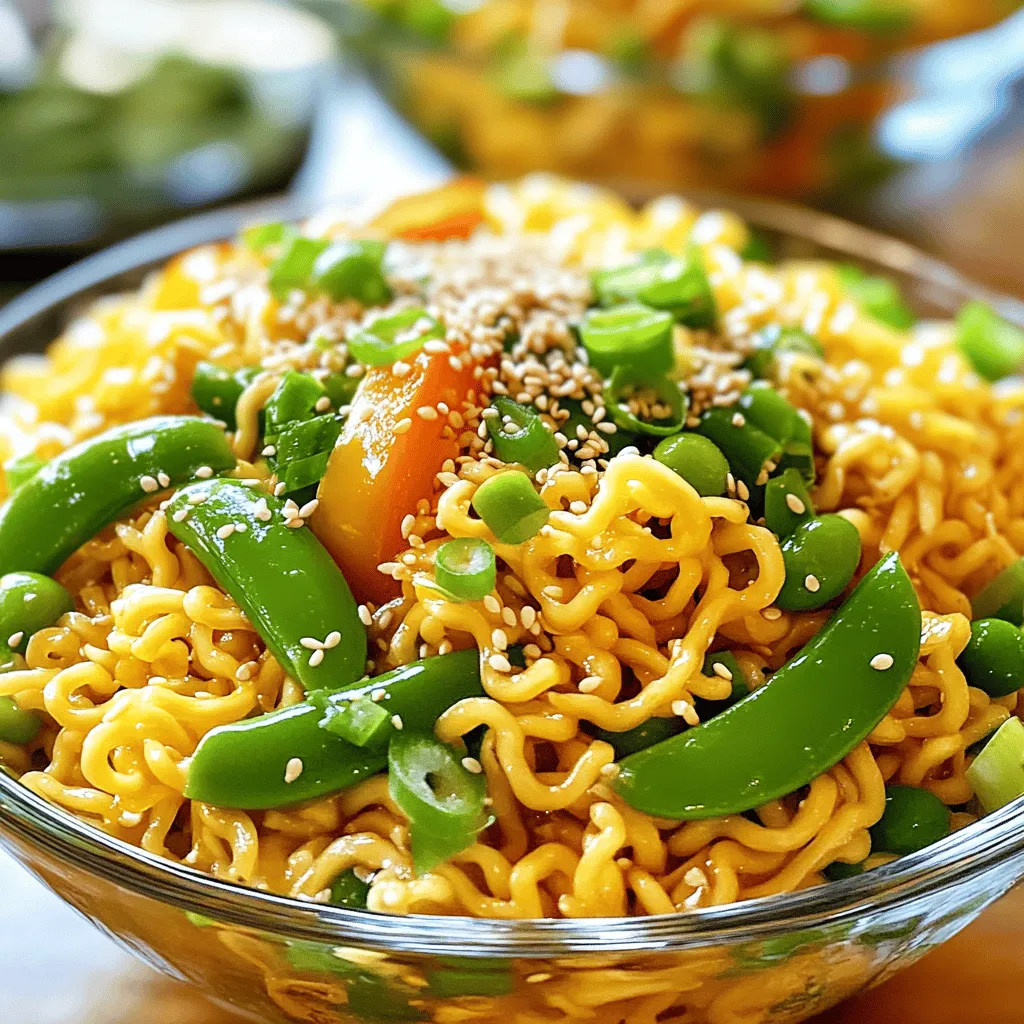Craving a quick meal that bursts with flavor? Let’s dive into my Savory Sesame Garlic Ramen Noodles recipe. This dish combines rich flavors from spices and sauces with easy cooking steps. Whether you’re a kitchen pro or just starting, I promise this recipe will delight your taste buds. Join me as we make a dish that’s not just tasty but also quick to whip up. Get ready to enjoy noodles like never before!

Ingredients
Main Ingredients for Ramen
– 2 packs of instant ramen noodles (discard the seasoning packets)
– 3 tablespoons sesame oil
– 4 cloves garlic, finely minced
– 1 inch fresh ginger, finely grated
– 1/2 cup green onions, finely sliced
– 1/2 cup snap peas, trimmed and halved
– 1/2 cup bell peppers, cut into thin strips
Sauces and Seasonings
– 3 tablespoons soy sauce
– 1 tablespoon rice vinegar
– 1 tablespoon brown sugar
Optional Add-Ins for Extra Flavor
– Toasted sesame seeds for garnish
– Sriracha sauce for added heat
The main ingredients here are instant ramen noodles, garlic, and ginger. They create a rich base. The sesame oil adds a nice nutty flavor. Green onions and vegetables like snap peas and bell peppers bring freshness. For the sauce, soy sauce, rice vinegar, and brown sugar balance salty and sweet notes.
Optional add-ins like toasted sesame seeds and Sriracha give a tasty finish and heat. You can mix and match these ingredients based on what you have. This recipe is flexible, making it fun to try new flavors!
Step-by-Step Instructions
Cooking the Noodles
To start, fill a large pot with water. Bring it to a full boil. Add the instant ramen noodles and cook them as the package says. You want them al dente, so check them often. Once cooked, drain the noodles. Make sure they do not stick together. Set them aside for later.
Preparing the Flavorful Sauce
Next, grab a small mixing bowl. In it, mix together the soy sauce, rice vinegar, and brown sugar. Use a whisk to blend these items well. Make sure the brown sugar dissolves fully. This sauce adds a tasty kick to your noodles.
Sautéing the Aromatics and Vegetables
Now, heat the sesame oil in a large skillet or wok on medium heat. When it’s hot, add the minced garlic and grated ginger. Sauté them for about one minute. Stir them often so they smell great but do not turn brown. Browning can make them taste bitter.
Combining Everything Together
After the garlic and ginger smell good, add the snap peas and bell peppers to the skillet. Stir-fry for two to three minutes. You want them to stay bright and crunchy. Then, add the drained ramen noodles to the skillet. Pour the sauce over everything. Gently toss all the ingredients to coat the noodles evenly. Cook for another two to three minutes until everything is hot.
Final Touches Before Serving
Finally, stir in the sliced green onions. If you want a spicy kick, add some Sriracha sauce. Mix everything well. Now, portion the sesame garlic ramen noodles into bowls. Top each bowl with toasted sesame seeds for a nice finish. Enjoy your delicious meal!
Tips & Tricks
Enhancing Flavor with Aromatics
To elevate your sesame garlic ramen, focus on fresh aromatics. I use garlic and ginger for a strong base. Mince the garlic finely and grate the ginger well. This ensures they release their flavor quickly. Sauté them gently in sesame oil to unlock their fragrance. Avoid browning them as it can turn bitter. The key is to stir often and enjoy that savory aroma.
Achieving the Perfect Noodle Texture
For the best noodle texture, cook the ramen until al dente. This means they should be firm when bitten. Follow the package instructions closely for timing. After cooking, drain the noodles and rinse them briefly in cold water. This helps stop the cooking process and keeps them from sticking. Toss them gently with a bit of sesame oil for added richness.
Presentation Ideas for Serving
Presentation matters! Serve the noodles in deep bowls for a cozy look. Scatter toasted sesame seeds on top for crunch. Add extra green onions for vibrant color. For a glossy finish, drizzle a little sesame oil just before serving. You can also arrange some snap peas neatly for a pop of green. It’s all about making your dish as inviting as it is delicious!

Variations
Adding Proteins: Chicken, Tofu, or Shrimp
You can boost this dish by adding proteins. Chicken, tofu, or shrimp work well. If you choose chicken, use cooked and shredded pieces. For tofu, press it to remove water, then cut it into cubes. Sauté the protein before adding the veggies. Shrimp cooks quickly, so add it to the pan last. Cook until pink and firm. This adds flavor and makes the meal heartier.
Vegetable Substitutions
Feel free to swap in your favorite veggies. Broccoli, carrots, or mushrooms are great options. You can also use bok choy for a nice crunch. Just chop them into small pieces. Add them to the skillet with the other veggies. This way, they cook evenly and blend nicely. The colors will make your dish pop and taste fresh.
Making it Spicy: Variations with Heat
If you like heat, add Sriracha or chili flakes. Start with a small amount and taste as you go. This lets you control the spice level. You can also use spicy sesame oil for extra flavor. Another option is to add fresh chopped chili peppers. They add a nice kick and look great on the plate. Enjoy experimenting with the heat to find your perfect balance!
Storage Info
Storing Leftovers Safely
After enjoying your ramen, let it cool. Place any leftovers in an airtight container. Store them in the fridge for up to three days. Keeping the noodles and veggies together maintains flavor. If you can, separate the noodles from the sauce to keep them from getting soggy.
Reheating Instructions
When you’re ready to eat, reheat the noodles on the stove. Add a splash of water to keep them moist. Heat over low to medium heat, stirring often. If you prefer the microwave, place the noodles in a bowl, cover with a damp paper towel, and heat in short bursts. Stir in between to ensure even heat.
Freezing Tips for Meal Prep
If you want to freeze your ramen, do so without the veggies. Cooked noodles can freeze well for up to a month. Place them in a freezer-safe bag. When ready to enjoy, thaw them in the fridge overnight. Reheat and add fresh veggies for the best taste. This method saves time and keeps your meals fresh!
FAQs
Can I use other types of noodles?
Yes, you can use other noodles. Try udon, soba, or rice noodles. Just cook them as directed. Each type gives a new taste and texture.
How can I make this recipe vegan?
To make this dish vegan, skip the brown sugar if it’s not vegan. Use maple syrup instead. Replace the soy sauce with tamari for a gluten-free option.
What can I substitute for sesame oil?
If you don’t have sesame oil, use olive oil or canola oil. These oils will work well, but you may miss the nutty flavor. Toasted sesame oil gives the best taste.
How spicy is Sriracha, and can I adjust it?
Sriracha has a medium spice level. If you want less heat, use less. You can also add more sugar to balance the spice. For more heat, add more Sriracha.
What’s the best way to add more vegetables?
You can add more vegetables easily! Try carrots, broccoli, or zucchini. Just chop them small and stir-fry them with the other veggies. This makes your dish colorful and healthy.
This blog post covered the essential ingredients and steps for making ramen. You learned about key ingredients, sauces, and optional add-ins that pack flavor. The step-by-step guide helps you cook noodles, prepare sauces, and combine everything for a delicious bowl. I shared tips for perfect texture and creative presentations. Variations allow you to customize with proteins and veggies. Plus, I included storage and reheating tips. Enjoy making ramen your way! Experiment and find your favorite mix. Happy cooking!

